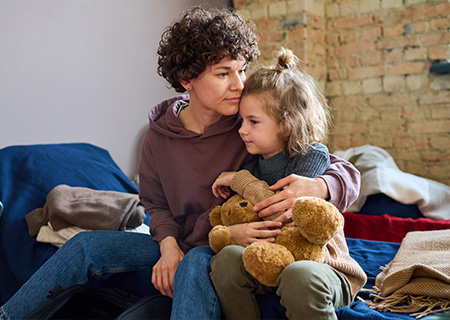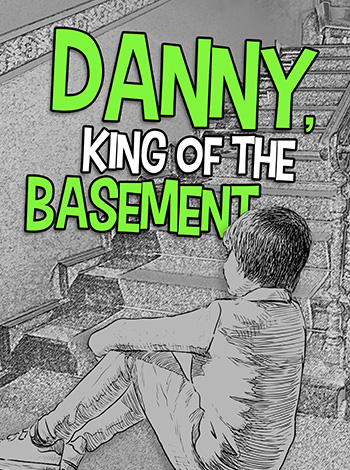Resource Guide - Danny, King of the Basement
Before the Show
Click on a topic to expand/hide content:
+ About the Show
+ The BIG Questions Before the Show
+ Vocabulary Enrichment
+ Activities
Making a friend
What is a friend? Good friends can make you feel happy and loved, while bad friends may disappoint you and make you sad.
Using suggestions from the whole class, list the qualities of a good friend on the board for everyone to see. Limit the list to no more than fifteen qualities. Then have students individually list their top ten qualities on a sheet of paper from those on the board. Rank them from most important (1) to least important (10).
Next, have the class break into small groups of 4-5 students. Have them compare their lists. Were your rankings the same or different? Which qualities weren’t ranked on anyone’s list? Would you change your ranking based on other student’s feedback about their list? Give students a chance to reorder their list if they need to.
Finally, the students will create a collage based on their personal list of the qualities of a good friend. A collage is a visual display that uses pictures, words, colors, and textures to show a big idea. It is often used to capture the mood or general feeling of an idea.
+ Effects of Homelessness on Children and Teens
 In the play, Danny and his mom don't become homeless, but they have money troubles every month. Mom's low income forces them to decide what items are the most important to buy. With limited resources, housing insecurity could be a real fear for Danny and his family.
In the play, Danny and his mom don't become homeless, but they have money troubles every month. Mom's low income forces them to decide what items are the most important to buy. With limited resources, housing insecurity could be a real fear for Danny and his family.
Children and teens who experience homelessness can be affected in many ways. Their education, health, sense of safety, and overall development may be impacted. Children and teens experiencing homelessness have been shown to:
+ About the Show
10-year-old Danny "Delco" Carter is the "king of moving." When Danny and his mom move into a basement apartment on an upscale street, the kids he meets have more material things, but they seem to have bigger challenges than he realizes. Danny’s imaginative play creates a sense of community that allows his friends to cope with their problems and, ultimately, to help Danny - because Danny's challenge isn't losing a home - it's gaining one.
Themes: Poverty, Friendship, the Power of Positivity
+ The BIG Questions Before the Show
- Danny changes schools frequently, he is often “the new kid.” What are some challenges of being a new student? Discuss ways that you and your class can make new students feel more welcome.
- This discussion might be sensitive and will come from a different starting point depending on the economic situation and the maturity of the class.
- What is your definition of poverty?
- What does a homeless person look like?
- Who is responsible for poverty? Is it the fault of the person or something else?
- Is it possible to make poverty disappear? How?
CCSS.ELA-Literacy.SL.(3-5).2: Ask and answer questions about key details in a text read aloud or information presented orally or through other media. CCSS.ELA-Literacy.RL.4.7: Make connections between the text of a story or drama and a visual or oral presentation of the text, identifying where each version reflects specific descriptions and directions in the text.
+ Vocabulary Enrichment
Pick three words from the list and use them in an original sentence or paragraph. You can also draw a picture, illustrating the definitions.
- escaping gerund: breaking free from confinement; avoiding something
- “blue chip” adj. idiom: of the highest quality; originally a term used to describe companies in the stock market
- amazing adj. causing great surprise or wonder
- salon n. a business that gives beauty treatments (such as haircuts)
- almost adv. not quite; very nearly
- disguise n. clothes or other things that you wear so that people will not recognize you
- swear v. to promise very strongly and sincerely to do or not do something
- “somebody to be reckoned with” n. phrase: to deal with a difficult or powerful person
- “true blue” adj. authentic, genuine or honest
- contacted v. past tense: to have communicated with someone or something
- mature adj. showing the qualities of an adult
- “brain freeze” n. idiom: temporary mental confusion or failure to perform
- proverb n. a short saying, stating a general truth or piece of advice
- spouted v. past tense: to shoot out (a liquid) with force
CCSS.ELA-Literacy.L.(K-5).4: Determine or clarify the meaning of unknown and multiple-meaning words and phrases.
+ Activities
Making a friend
What is a friend? Good friends can make you feel happy and loved, while bad friends may disappoint you and make you sad.
Using suggestions from the whole class, list the qualities of a good friend on the board for everyone to see. Limit the list to no more than fifteen qualities. Then have students individually list their top ten qualities on a sheet of paper from those on the board. Rank them from most important (1) to least important (10).
Next, have the class break into small groups of 4-5 students. Have them compare their lists. Were your rankings the same or different? Which qualities weren’t ranked on anyone’s list? Would you change your ranking based on other student’s feedback about their list? Give students a chance to reorder their list if they need to.
Finally, the students will create a collage based on their personal list of the qualities of a good friend. A collage is a visual display that uses pictures, words, colors, and textures to show a big idea. It is often used to capture the mood or general feeling of an idea.
NCES.RED.SE.2: Understand the relationship between self and others in the broader world. NCES-VisualArts.(3-5).VA.V.3: Create art using a variety of tools, media, and processes, safely and appropriately.
+ Effects of Homelessness on Children and Teens
 In the play, Danny and his mom don't become homeless, but they have money troubles every month. Mom's low income forces them to decide what items are the most important to buy. With limited resources, housing insecurity could be a real fear for Danny and his family.
In the play, Danny and his mom don't become homeless, but they have money troubles every month. Mom's low income forces them to decide what items are the most important to buy. With limited resources, housing insecurity could be a real fear for Danny and his family.
Children and teens who experience homelessness can be affected in many ways. Their education, health, sense of safety, and overall development may be impacted. Children and teens experiencing homelessness have been shown to:
- Have higher levels of emotional and behavioral problems.
- Have an increased risk of serious health problems.
- Are more likely to experience separations from their families.
- Experience more school mobility, like repeating a grade, getting expelled, or dropping out. This can lead to lower academic performance.
After the Show
Click on a topic to expand/hide content:
+ The BIG Questions After the Show
+ Activities
Brain Freeze and Self-Talk
In the play, the characters talk about times when they get a bad idea or a negative thought in their head and can’t get it out. They refer to this as a "brain freeze."
Angelo gets a brain freeze on the hockey rink. Penelope gets a brain freeze in her ballet class. Danny gets a brain freeze when he’s asked to read aloud at school. When this happens, the friends perform an "operation" to remove the negative thoughts. They also use a technique called self-talk to beat the brain freeze.
Self-talk is when you talk to yourself in your head or out loud about what's going on. Our self-talk can be cheerful and supportive or negative and self-defeating. Self-talk can be beneficial when it’s positive, calming fears and bolstering confidence. Unfortunately, humans often engage in negative self-talk, making sweeping statements like "I can't do anything right" or "I'm a complete failure." These absolute, generalized statements are never true. But they get reinforced the more we repeat them, until we accept them as true.
When you talk to yourself, it's better to use "you" or "he/she" instead of "I," even for positive self-talk. This creates some psychological distance, as if you are talking to a different person. When we talk to ourselves about thriving instead of just surviving, it can motivate us to achieve our goals. Some examples of positive self-talk could be:
Monthly Budget
Click the button to see a printable worksheet for your classroom or family.
Monthly Budget
+ Stress reactions
 When we're stressed, our body chemistry changes to make us stronger, faster, and more alert. It's how it protects us from immediate danger. Our heart rate and blood pressure increases. Stress hormones such as adrenaline and cortisol surge through the body.
When we're stressed, our body chemistry changes to make us stronger, faster, and more alert. It's how it protects us from immediate danger. Our heart rate and blood pressure increases. Stress hormones such as adrenaline and cortisol surge through the body.
The amygdala, or the reactive part of our brain, causes this reaction. It can also be known as our "fight or flight" instinct. These stress reactions help in short-term situations, like when we're running away from something dangerous. When the amygdala takes control, it temporarily turns off the thinking part of the brain called the prefrontal cortex. This part of the brain is in charge of problem solving, impulse control, and regulating emotions. When we are in danger, it's important to act quickly without overthinking and wasting time.
When we are in long-term stressful situations, our brains keep producing those hormones. It keeps our heart rate raised, and makes it very difficult to think, plan, or regulate our emotions. It’s important to learn how to engage our prefrontal cortex to override the automatic response of “fight or flight” if it’s not appropriate to the situation. This practice is sometimes called resilience.
Resilience is being able to bounce back from stress, trauma or adversity. When children are resilient, they are more curious, more adaptable, and more able to extend their reach into the world.
The great news is that resilience is something that can be nurtured in all children. For some ideas, read Building Resilience in Children - 20 Practical, Powerful Strategies from heysigmund.com.
+ Talk About Theatre Jobs
+ External Links
+ Recommended Reading
+ The BIG Questions After the Show
- In the play, when did you realize Danny couldn’t read? How do you think moving around had an impact on his learning to read? What would be some difficulties you might encounter if you couldn’t read?
- Why do you think Danny’s mom wasn’t honest with him about his father? Was Danny angry about it? Why or why not?
CCSS.ELA-Literacy.SL.(3-5).2: Ask and answer questions about key details in a text read aloud or information presented orally or through other media. CCSS.ELA-Literacy.SL.4.1.D: Review the key ideas expressed and explain their own ideas and understanding in light of the discussion.
+ Activities
Brain Freeze and Self-Talk
In the play, the characters talk about times when they get a bad idea or a negative thought in their head and can’t get it out. They refer to this as a "brain freeze."
Angelo gets a brain freeze on the hockey rink. Penelope gets a brain freeze in her ballet class. Danny gets a brain freeze when he’s asked to read aloud at school. When this happens, the friends perform an "operation" to remove the negative thoughts. They also use a technique called self-talk to beat the brain freeze.
Self-talk is when you talk to yourself in your head or out loud about what's going on. Our self-talk can be cheerful and supportive or negative and self-defeating. Self-talk can be beneficial when it’s positive, calming fears and bolstering confidence. Unfortunately, humans often engage in negative self-talk, making sweeping statements like "I can't do anything right" or "I'm a complete failure." These absolute, generalized statements are never true. But they get reinforced the more we repeat them, until we accept them as true.
When you talk to yourself, it's better to use "you" or "he/she" instead of "I," even for positive self-talk. This creates some psychological distance, as if you are talking to a different person. When we talk to ourselves about thriving instead of just surviving, it can motivate us to achieve our goals. Some examples of positive self-talk could be:
- “You can do this.”
- “He needs to keep trying.”
- “Even though she's nervous, she is not giving up.”
NCES-TheatreArts.(3-5).TA.AC.2: Use performance to communicate ideas and feelings. CCSS.ELA-Literacy.W.(3-5).3: Write narratives to develop real or imagined experiences using effective technique, descriptive details, and clear event sequences. NCES.RED.SE.1.2: Identify ways of controlling behaviors associated with emotional states, feelings, and moods.
Monthly Budget
Click the button to see a printable worksheet for your classroom or family.
Monthly Budget
+ Stress reactions
 When we're stressed, our body chemistry changes to make us stronger, faster, and more alert. It's how it protects us from immediate danger. Our heart rate and blood pressure increases. Stress hormones such as adrenaline and cortisol surge through the body.
When we're stressed, our body chemistry changes to make us stronger, faster, and more alert. It's how it protects us from immediate danger. Our heart rate and blood pressure increases. Stress hormones such as adrenaline and cortisol surge through the body.
The amygdala, or the reactive part of our brain, causes this reaction. It can also be known as our "fight or flight" instinct. These stress reactions help in short-term situations, like when we're running away from something dangerous. When the amygdala takes control, it temporarily turns off the thinking part of the brain called the prefrontal cortex. This part of the brain is in charge of problem solving, impulse control, and regulating emotions. When we are in danger, it's important to act quickly without overthinking and wasting time.
When we are in long-term stressful situations, our brains keep producing those hormones. It keeps our heart rate raised, and makes it very difficult to think, plan, or regulate our emotions. It’s important to learn how to engage our prefrontal cortex to override the automatic response of “fight or flight” if it’s not appropriate to the situation. This practice is sometimes called resilience.
Resilience is being able to bounce back from stress, trauma or adversity. When children are resilient, they are more curious, more adaptable, and more able to extend their reach into the world.
The great news is that resilience is something that can be nurtured in all children. For some ideas, read Building Resilience in Children - 20 Practical, Powerful Strategies from heysigmund.com.
+ Talk About Theatre Jobs
Every play Children’s Theatre of Charlotte produces is created by a talented team of designers, technicians, actors, and a director. As a class, discuss what you experienced when you saw the performance.
- Name three things you noticed about the scenery. Did the scenery help tell the story? What sort of scenery would you design?
- What did you like about the costumes? Did the costumes help tell the story? What sort of costumes would you design?
- What role did lighting play in telling the story? How did the lights enhance what you were seeing?
- Talk about the actors. Were there moments you were so caught up in the story you forgot you were watching a play?
- Were there any actors who played more than one character? What are some ways you can show you are a different character?
NCES-TheaArts.(3-5).TA.A.1: Analyze literary texts and performances. NCES-TheaArts.(3-5).TA.AE.1.2: Understand how costumes [and technical elements] enhance dramatic play.
+ External Links
- Confronting Poverty provides a set of tools for learning more about poverty and inequality in the United States. You can use the discussion guides or the poverty risk calculator on their website.
- Learn more about resilience from the American Psychological Association, and the ways it can be cultivated and practiced.
- The National Center for Homeless Education has provided resources for addressing educational challenges with highly mobile students, as well as videos to raise awareness about homelessness with your classroom.
- Charlotte Family Housing works with currently homeless, working families on a path to self-sufficiency. Check out the ways to support their mission.
+ Recommended Reading
If you enjoyed the show, travel to ImaginOn or your local Charlotte Mecklenburg Library branch and check out these books. Check availability at cmlibrary.org.
- Crenshaw by Katherine Applegate
- All Rise for the Honorable Perry T. Cook by Leslie Connor
- A Duet for Home by Karina Yan Glaser
- Peace, Locomotion by Jacqueline Woodson

BY David S. Craig



